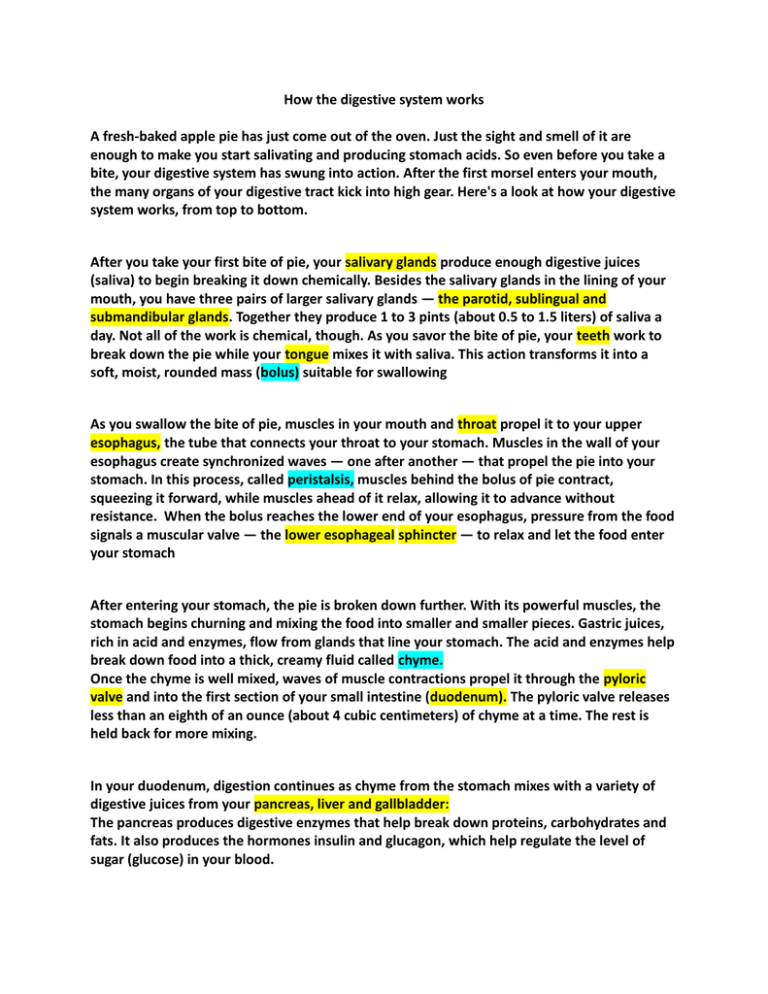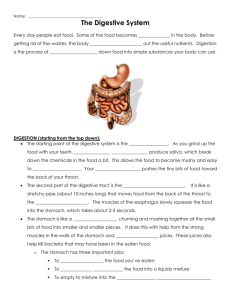How the Digestive System Works
advertisement

How the digestive system works A fresh-baked apple pie has just come out of the oven. Just the sight and smell of it are enough to make you start salivating and producing stomach acids. So even before you take a bite, your digestive system has swung into action. After the first morsel enters your mouth, the many organs of your digestive tract kick into high gear. Here's a look at how your digestive system works, from top to bottom. After you take your first bite of pie, your salivary glands produce enough digestive juices (saliva) to begin breaking it down chemically. Besides the salivary glands in the lining of your mouth, you have three pairs of larger salivary glands — the parotid, sublingual and submandibular glands. Together they produce 1 to 3 pints (about 0.5 to 1.5 liters) of saliva a day. Not all of the work is chemical, though. As you savor the bite of pie, your teeth work to break down the pie while your tongue mixes it with saliva. This action transforms it into a soft, moist, rounded mass (bolus) suitable for swallowing As you swallow the bite of pie, muscles in your mouth and throat propel it to your upper esophagus, the tube that connects your throat to your stomach. Muscles in the wall of your esophagus create synchronized waves — one after another — that propel the pie into your stomach. In this process, called peristalsis, muscles behind the bolus of pie contract, squeezing it forward, while muscles ahead of it relax, allowing it to advance without resistance. When the bolus reaches the lower end of your esophagus, pressure from the food signals a muscular valve — the lower esophageal sphincter — to relax and let the food enter your stomach After entering your stomach, the pie is broken down further. With its powerful muscles, the stomach begins churning and mixing the food into smaller and smaller pieces. Gastric juices, rich in acid and enzymes, flow from glands that line your stomach. The acid and enzymes help break down food into a thick, creamy fluid called chyme. Once the chyme is well mixed, waves of muscle contractions propel it through the pyloric valve and into the first section of your small intestine (duodenum). The pyloric valve releases less than an eighth of an ounce (about 4 cubic centimeters) of chyme at a time. The rest is held back for more mixing. In your duodenum, digestion continues as chyme from the stomach mixes with a variety of digestive juices from your pancreas, liver and gallbladder: The pancreas produces digestive enzymes that help break down proteins, carbohydrates and fats. It also produces the hormones insulin and glucagon, which help regulate the level of sugar (glucose) in your blood. The liver performs more than 500 functions, including storing nutrients, filtering and processing chemicals in food, and producing bile, a solution that helps digest fats and eliminate waste products. Gallbladder. The gallbladder stores and concentrates bile. As fatty food enters the upper portion of your small intestine (the duodenum), the gallbladder contracts and forces bile into the small intestine through the common bile duct. As bile and pancreatic digestive juices mix with other juices secreted by the wall of your small intestine, digestion continues. What was once apple pie is propelled into the second portion of your small intestine, the jejunum. Here it's further broken down into smaller molecules of nutrients that can be absorbed. Then it moves into the final and longest portion of your small intestine — the ileum — where virtually all of the remaining nutrients are absorbed through the lining of the ileum's wall. What remains of the food when it reaches the end of the ileum is a combination of water, electrolytes — such as sodium and chloride — and waste products, such as plant fiber and dead cells shed from the lining of your digestive tract. As this residue passes through the colon, nearly all of the water is absorbed, leaving a usually soft but formed substance called stool. Muscles in the wall of your colon separate the waste into small segments that are pushed into your lower colon and rectum. As the rectal walls are stretched, they signal the need for a bowel movement. When the sphincter muscles in your anus relax, the rectal walls contract to increase pressure. These coordinated muscle contractions expel the stool. Anal sphincter Ascending colon Transverse Descending









